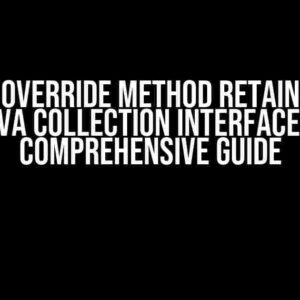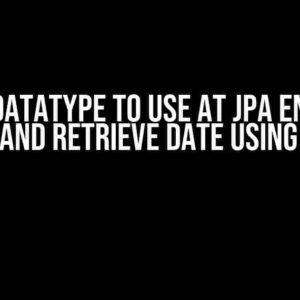When working with Hibernate and Data Transfer Objects (DTOs), it’s essential to implement the equals method correctly to ensure data consistency and integrity. In this article, we’ll delve into the world of Hibernate and DTOs, exploring how to extract a method for use in the equals implementation.
What is Hibernate?
Hibernate is a popular Object-Relational Mapping (ORM) tool that helps developers interact with databases using Java. It acts as a bridge between the Java application and the relational database, providing a more efficient and effective way to perform CRUD (Create, Read, Update, and Delete) operations.
What are DTOs?
Data Transfer Objects (DTOs) are lightweight, serializable objects used to transfer data between layers or systems. They typically contain the data necessary for a specific task or operation, making them an ideal choice for data transmission between the presentation layer and the business layer.
Why do we need to implement the equals method?
The equals method is a crucial part of any Java object, as it allows us to compare two objects for equality. When working with Hibernate and DTOs, implementing the equals method correctly is vital to ensure data consistency and integrity. Failing to do so can lead to issues with data retrieval, updates, and deletions.
Challenges with implementing the equals method in Hibernate DTOs
Implementing the equals method in Hibernate DTOs can be challenging due to the following reasons:
- Identity vs. Equality**: Hibernate uses the identity of objects (i.e., their memory address) to determine equality, whereas DTOs rely on the equality of their properties.
- Lazy Loading**: Hibernate’s lazy loading mechanism can lead to issues when comparing objects, as some properties might not be loaded at the time of comparison.
- Transient Properties**: DTOs often contain transient properties that should not be included in the equality check.
Extracting a method for use in the equals implementation
To overcome these challenges, we can extract a method that takes into account the unique characteristics of Hibernate DTOs. This method will serve as a foundation for our equals implementation.
public boolean isEqualDTOs(DTO dto1, DTO dto2) {
if (dto1 == dto2) return true;
if (dto1 == null || dto2 == null) return false;
// Check for equality of business key properties
// (e.g., id, name, email, etc.)
if (!Objects.equals(dto1.getId(), dto2.getId())) return false;
if (!Objects.equals(dto1.getName(), dto2.getName())) return false;
// ...
return true;
}
The `isEqualDTOs` method takes two DTO objects as input and returns a boolean indicating whether they are equal. This method first checks for identity and nullity, and then compares the business key properties (such as id, name, email, etc.) for equality.
Using the isEqualDTOs method in the equals implementation
Now that we have our `isEqualDTOs` method, we can use it in the equals implementation of our DTO class:
@Override
public boolean equals(Object obj) {
if (this == obj) return true;
if (obj == null || getClass() != obj.getClass()) return false;
DTO dto = (DTO) obj;
return isEqualDTOs(this, dto);
}
The `equals` method first checks for identity and class equality, and then delegates the comparison to the `isEqualDTOs` method.
Best practices for implementing the equals method in Hibernate DTOs
To ensure data consistency and integrity, follow these best practices when implementing the equals method in Hibernate DTOs:
- Use the business key properties**: Focus on the properties that uniquely identify your DTO objects, such as id, name, email, etc.
- Exclude transient properties**: Transient properties should not be included in the equality check to avoid unnecessary comparisons.
- Handle lazy loading**: Be mindful of Hibernate’s lazy loading mechanism and ensure that all necessary properties are loaded before comparison.
- Implement hashCode correctly**: Remember to implement the hashCode method in accordance with the equals method to maintain data integrity.
Conclusion
In this article, we’ve explored the challenges of implementing the equals method in Hibernate DTOs and extracted a method to use in the equals implementation. By following best practices and using the `isEqualDTOs` method, you can ensure data consistency and integrity in your Hibernate-based applications.
| Best Practice | Description |
|---|---|
| Use business key properties | Focus on properties that uniquely identify your DTO objects |
| Exclude transient properties | Avoid unnecessary comparisons by excluding transient properties |
| Handle lazy loading | Ensure all necessary properties are loaded before comparison |
| Implement hashCode correctly | Maintain data integrity by implementing hashCode in accordance with equals |
By following these guidelines and using the `isEqualDTOs` method, you’ll be well on your way to ensuring data consistency and integrity in your Hibernate-based applications.
Frequently Asked Question
Get ready to dive into the world of Hibernate DTOs and discover the secrets of extracting methods for equals implementation!
What is the main purpose of overriding the equals method in Hibernate DTOs?
Overriding the equals method in Hibernate DTOs allows you to define a custom equality check based on the business logic of your application. This is essential because Hibernate uses the equals method to determine whether two objects are identical, which affects the behavior of its caching mechanism, lazy loading, and other features.
How do I extract a method to use in the equals implementation with Hibernate DTOs?
To extract a method, identify the unique identifying attributes of your DTO and create a custom method that compares these attributes. For example, if your DTO has a unique ID, you can create a method that compares two IDs for equality.
What are the key considerations when implementing the equals method in Hibernate DTOs?
When implementing the equals method, consider the following: ensure the method is symmetric, transitive, and reflexive; handle null checks and avoid using getters that can trigger lazy loading; and make sure the method is consistent with the hashCode method.
Can I use the default equals method provided by the Object class in Hibernate DTOs?
No, you should not rely on the default equals method provided by the Object class. This method checks for object reference equality, which is not suitable for Hibernate DTOs. Instead, you should override the equals method to define a custom equality check based on your application’s business logic.
How does the equals method affect the performance of Hibernate applications?
A well-implemented equals method can improve the performance of Hibernate applications by reducing the number of unnecessary database queries and caching operations. On the other hand, a poorly implemented equals method can lead to performance issues, such as excessive caching and slower query execution.




